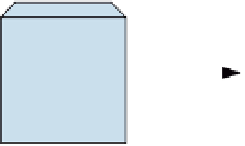Biomedical Engineering Reference
In-Depth Information
An example of a hydrogen bond is found among water molecules. The oxygen in water,
which is negatively charged, binds to two positively charged hydrogens from two other
water molecules. These bonds connect the water molecules together and give it some
unusual properties, such as high surface tension and viscosity. Keep in mind that this bond
is a relatively weak bond compared to that holding the water molecule together. As water is
heated to the boiling point, all of the hydrogen bonds are dissolved as it becomes a gas.
When water freezes, the hydrogen bonds form a structured, less dense orientation. Between
freezing and boiling, water is oriented in very dense, random configuration. Hydrogen also
plays an an important role within proteins and nucleic acids, which allows bonding within
the molecule to achieve different shapes.
A chemical reaction in which a molecule loses electrons is called oxidation, and a gain of
electrons is called reduction. Some multistage chemical reactions involve both oxidation
and reduction. Energy is released when a chemical bond is formed, which is the same
amount of energy necessary to break that chemical bond. Thus, chemical bonds store
energy. The first step in a chemical reaction requires energy to break the bonds holding
the reactant molecules together so they can be rearranged to form an activated complex,
an unstable high-energy intermediate. From the activated complex, the molecules join
together to form the product and typically release energy. In chemical reactions, if the
energy stored in the chemical bonds of the product is less than the total energy stored in
the reactants, then net energy is released. The amount of energy required in a chemical
reaction is inversely proportional to the reaction rate constant.
8.1.2 Kinetics of a Single-Stage Chemical Reaction
To understand the law of mass action, a compartment model visualization of Eq. (8.1) is
shown in Figure 8.1, with the understanding that the volumes for the two compartments are
identical (i.e., the reaction occurs in a single container of constant volume). The differential
equation describing Eq. (8.1) or Figure 8.1 is
q
A
¼
Kq
A
q
B
ð
8
:
2
Þ
where
is the transfer rate or reaction
rate constant. The transfer rate includes the volume in converting the concentrations to
quantities in Eq. (8.2). Note that the right-hand side of Eq. (8.2) involves the product
q
A
q
B
, instead of a single variable as before. In addition, we could have written Eq. (8.2) in
terms of
q
A
and
q
B
are the quantities of reactants
A
and
B
, and
K
q
P
¼
Kq
A
q
B
. Since drawing the compartmental
model is not essential in writing the differential equation that describes the kinetics of the
q
B
,
q
B
¼
Kq
A
q
B
or in terms of
q
P
,
K
q
A
q
B
q
P
FIGURE 8.1
Compartmental model of the single-stage chemical reaction in Eq. (8.1). Another way to describe
this system is to remove one of the reactants in the left box and include it as part of the reaction rate—that is,
Kq
B
:






